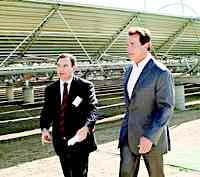Friday 31/10/2008 Page: 11
 A GOVERNMENT grants program to help small and medium-size manufacturers improve their environmental performance is now under way, with applications for the first round of funding being considered. The $75 million program, Re-Tooling for Climate Change, being administered by AusIndustry, will provide grants of between $10,000 and $500,000, up to a maximum of one third of the cost of each project. An eligible applicant must be a non-tax exempt manufacturing company, with an annual group turnover of less than $100 million in each of the three financial years before the year of application lodgment, and must be able to fund the costs of the project not met by the grant.
A GOVERNMENT grants program to help small and medium-size manufacturers improve their environmental performance is now under way, with applications for the first round of funding being considered. The $75 million program, Re-Tooling for Climate Change, being administered by AusIndustry, will provide grants of between $10,000 and $500,000, up to a maximum of one third of the cost of each project. An eligible applicant must be a non-tax exempt manufacturing company, with an annual group turnover of less than $100 million in each of the three financial years before the year of application lodgment, and must be able to fund the costs of the project not met by the grant.Successful applicants for the first round of applications should be notified before the end of the year. Applications for the second round will be invited early in the first half of 2009. About $11 million is available for payments in the first year of the program, and about $22 million in the second year. So far, AusIndustry is happy with the process. "We have conducted a series of seminars over the past two months, and worked closely with industry associations," says Bronwyn Williams, AusIndustry program manager.
"The program has attracted a lot of interest, and we expect that the pace of applications will really pick up in the second round. We believe that a lot of companies are carefully doing their homework to put together the best possible application, and that's an approach we support." Examples of eligible projects include: investing in co-generation power plants that capture waste energy and rise it to generate electricity for production; stormwater capture and improving water recycling for reuse in manufacturing; improving insulation and recovering waste heat to improve process efficiency; and process re-engineering involving the adoption of energy efficient manufacturing tools.
The commissioning of energy audits is not covered, although Williams notes that the key points of any audits or consultant studies can be provided in support of a grant application. "We are looking for projects that support the long-term sustainability of Australian manufacturing," she says.
"To get a grant, a project can't just be about replacing a piece of worn-out equipment with something that offers marginally better performance. It has to be more than routine business, and show a commitment to reduce the environmental footprint of the manufacturing operation over the long tern." Applications will be considered by Innovation Australia, which will assess and rate the merit of applications.
Innovation Australia will consider the impact of an applicant's project on its operational efficiency or carbon emissions, as well as any wider industry impact. The nature of the supporting evidence required as part of the application will depend on the size of the grant sought. Successful applicants will need to enter into a grant agreement to receive funding, and report on progress. The nature of the supporting evidence required as part of the application will depend on the size of the grant sought. Successful applicants will need to enter into a grant agreement to receive funding, and report on progress. In the seminars and discussions to date, we have seen a great deal of interest in environmental issues from the business community," says Williams.
This program will, I think, provide an additional incentive for turning interest into action." The four year Re-tooling for Climate Change program is one component of the Clean Business Australia initiative. Other programs are the Climate Ready program (grants of $75 million over four _years), supporting the development and commercialisation of technologies that provide solutions for climate change, and the Green Building Fund ($90 million over four years) that will help building owners to improve the energy efficiency of existing commercial office buildings.
Applications for grants roust be made using the form provided by AusIndustry available through the site www.ausindustry. gov.au (click on "AusIndustry products' and follow the links to Retooling for Climate Change). Further information can be obtained through the AusIndustry Hotline on 13 28 46 or by email at hotline@ausindustry.gov.au


